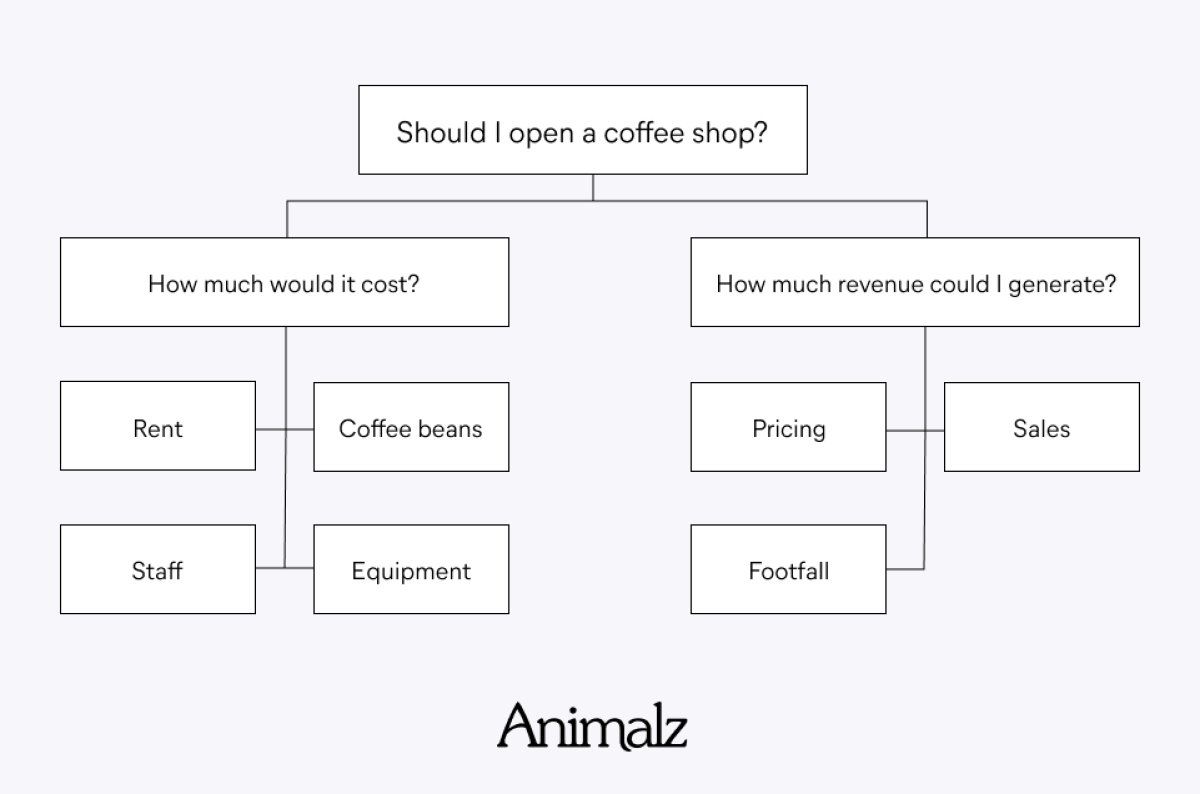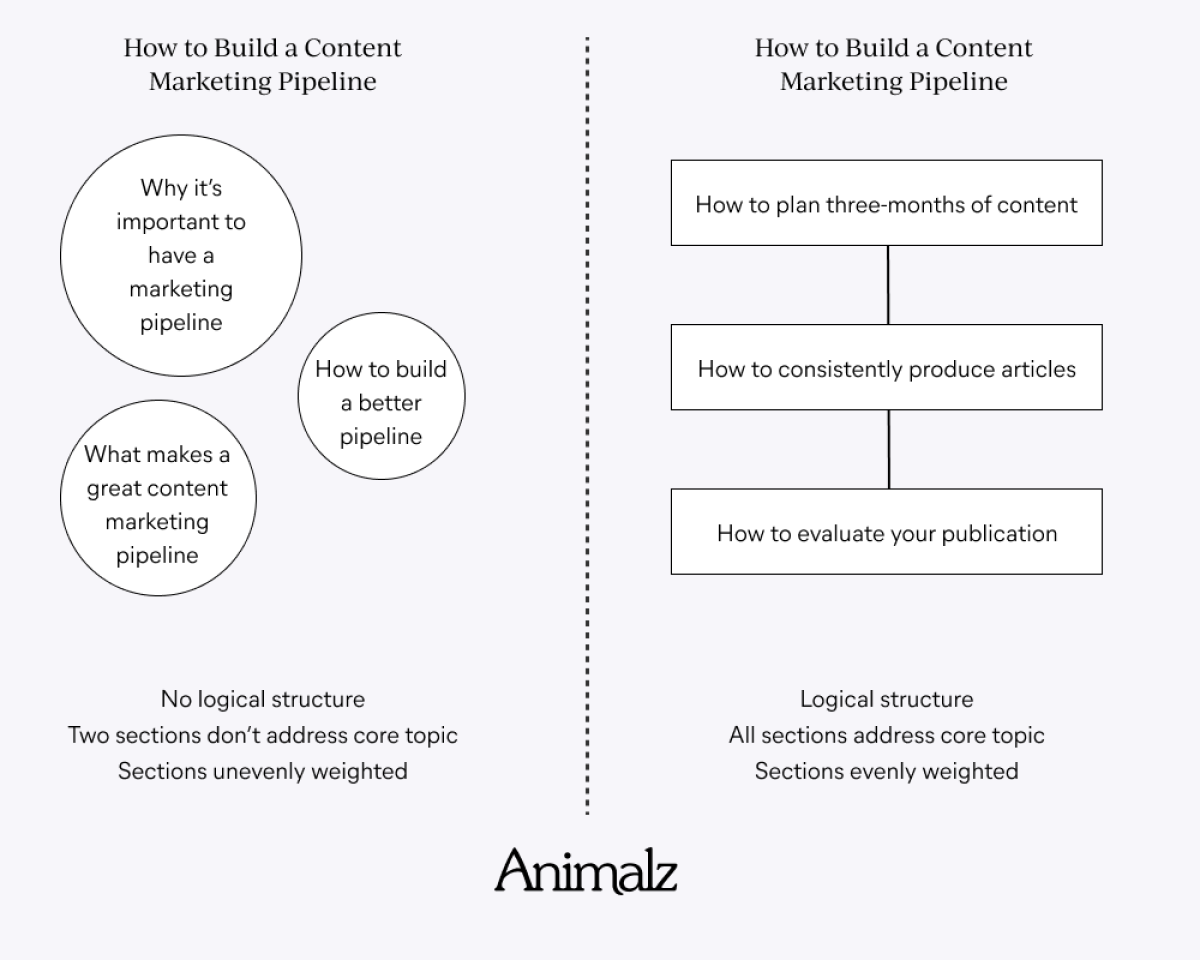Mutually exclusive, collectively exhaustive (MECE) is one of the core problem-solving frameworks in management consulting. It can also be a powerful method for better writing.
Consulting firms like Bain, McKinsey, and BCG use case interviews as a core part of their selection process for new consultants. In a case interview, candidates are asked to solve an intentionally broad challenge, like how to equitably distribute funds to an Ebola-stricken country or how to assess the viability of opening a new coffee shop.The MECE framework—invented by legendary McKinsey consultant Barbara Minto—allows candidates to tackle these open-ended challenges in a logical and thorough way. It guarantees a baseline of clarity when faced with even the most unexpected challenges. It ensures no obvious gaps in their logic and no glaring oversights.When applied to content marketing, MECE can supercharge your writing. It allows you to create persuasive, comprehensive content on virtually any topic. It gets your thinking off the page and ensures that your articles deliver on their promises.
The Basics of MECE
According to MECE, within any set of data, information should be
mutually exclusive (ME), or grouped into sets that don’t overlap with one another; and
collectively exhaustive (CE), or organized so that there are no obvious omissions or “gaps” in the information.
Your data should cover the entire space it set out to define, and none of the constituent elements should overlap. If that’s true, the data set is MECE.
Pretty simple: If you write a recipe for a peanut butter and jelly sandwich that leaves out the jelly, your recipe isn’t collectively exhaustive. Similarly, if you write an article promising “4 Strategies for Better Mobile App Retention” that offers only three strategies, your article isn’t collectively exhaustive.Also simple: If step 2 of your recipe is “slather peanut butter and jelly on both pieces of bread,” and step 3 is “now add the jelly,” your recipe isn’t mutually exclusive. If two of the strategies in your article are both about using tooltips for better onboarding, your article isn’t mutually exclusive.
How to Make Your Writing MECE
Management consultants use the MECE framework by creating visual decision maps, called “issue trees,” that break down a problem into its constituent parts. For “opening a coffee shop,” one issue tree might branch out into cost (rent, equipment, staff, coffee beans) and revenue (pricing, likely footfall in a given location, number of sales).

In writing, we can apply the same process to article outlines. Most article ideas come from a problem we want to solve or an opinion we want to voice. The first step is to break down the topic into its component parts, and ask, “What information is necessary to answer the article’s core question?”
Get Your Thinking off the Page
In applying this process, many article outlines inadvertently reveal the writer’s own thought process about the topic. Let’s take the example topic How to Build a Content Marketing Pipeline. Here’s a pretty common article structure we could use for our outline:
Section 1 Why it’s important to have a content marketing pipeline Section 2 What makes a great content marketing pipeline Section 3 How to build a better content marketing pipeline How to Build a Better Content Marketing Pipeline
You can see how the writer’s own research and reasoning have dictated the structure of the piece: they opened up Google and asked, “Well, why would I need a content pipeline in the first place?” and then wrote about that. At first glance, this structure seems reasonable, but it completely fails at being MECE.It’s not collectively exhaustive because it doesn’t capture the full range of data necessary to help you build a content marketing pipeline—two out of three sections don’t even touch on the topic. It’s not mutually exclusive because the third section—“How to build a better content marketing pipeline”—is the same as the title of the post.If we wrote this article, we’d end up with 2,000 words of copy that largely skirted around the topic at hand: how to build a content marketing pipeline. The context-setting sections would be too long, and the meaty “how to” portion would be too short.
Apply a Logical Structure
There are an infinite number of ways to organize an article, and a key part of being MECE is identifying a useful structure for the topic you want to cover. Most content marketing is designed to help the reader do something, like improve their keyword research or reduce customer churn. How to Build a Content Marketing Pipeline is no exception.Instead of structuring the article around your own internal monologue, a better approach is to outline it with a process structure in mind. We’re teaching the reader to do something, so the article should share the constituent steps of a process. It should have a start, a middle, and an end. Each point should follow on from the conclusion of the previous.Viewed through this lens, it becomes easier to create a MECE structure for How to Build a Content Marketing Pipeline. A prerequisite to writing lots of content is planning lots of content. Next, we can focus on the minutiae of writing those ideas. Lastly, we’d want to know how our content performed, in order to feed back into planning the next round of content:
Section 1 How to plan three-months of content Section 2 How to consistently produce articles Section 3 How to evaluate and analyze your publication How to Build a Better Content Marketing Pipeline
In this example, we cover everything that happens before you start writing content, everything that happens during its actual creation, and everything required to learn from what you publish.

There’s no overlap between sections; each addresses a different stage of the process, and they add up to something that feels like a comprehensive take on the subject.
Scope Out the Length of Each Section
Many articles fail to be MECE because they end up too long and bloated, or too short to do the topic justice.The process of breaking down a topic into its component parts could be repeated infinitely, and the pursuit of collective exhaustiveness could easily lead to articles tens of thousands of words long. But the longer an article becomes, the easier it is to end up rehashing the same information (hence, not mutually exclusive).Even more common are articles that attempt to tackle huge, meaty topics without affording them the word count required to be collectively exhaustive. Great MECE content is only as long as it needs to be:
Why the Best Content Happens Fast doesn’t need to be long. It’s a single thought, and the article can be collectively exhaustive within the scope of 600 words.
BLUF: The Military Standard That Can Make Your Writing More Powerful is more complex. We need to define the concept, highlight its application within writing, and use examples to demonstrate the principle in action. To write a MECE article, we needed 1,700 words.
Napkin math at the outline stage can be useful for scoping the required length of the article. How to Build a Better Content Marketing Pipeline contains three sections. Each is roughly as important as the others, so we want to allocate an even word count to each.With a guesstimate of 500 words per section, and a short introduction and conclusion, we’re likely to need 1,500-2,000- words to make the topic MECE:
Introduction ~100 words Section 1 How to plan three-months of content ~500 words Section 2 How to consistently produce articles ~500 words Section 3 How to evaluate and analyze your publication ~500 words Conclusion ~100 words How to Build a Better Content Marketing Pipeline
Estimating length like this helps ensure that a finished article delivers on the MECE structure we intend for it. We can identify the core topics, estimate the relative importance of each, and ensure that we allocate enough time and energy to making each section distinct and comprehensive.
Consistently Persuasive Writing with MECE
Most writing on the web mirrors the thought process of its writer. While that isn’t a universally bad way to write, there’s normally a better framework for structuring any article or argument.
MECE is a valuable tool for creating thorough, persuasive structures in a consistent way. It ensures that each topic is covered in sufficient depth (collectively exhaustive) without needless repetition or bloat (mutually exclusive), and it guarantees that your writing delivers on its promise.
